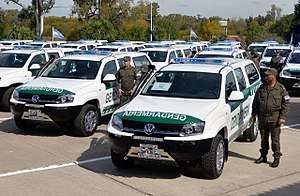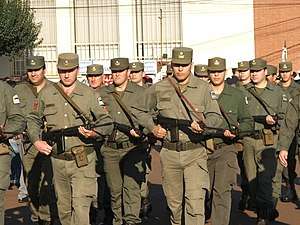Argentine National Gendarmerie
The Argentine National Gendarmerie (Spanish: Gendarmería Nacional Argentina, GNA) is the gendarmerie and corps of border guards of Argentina.
| Argentine National Gendarmerie Gendarmería Nacional Argentina | |
|---|---|
 Emblem of the Force | |
 Gendarmeria flag | |
| Abbreviation | GNA |
| Motto | Centinela de la Patria (eng: "Fatherland's Sentinel") |
| Agency overview | |
| Formed | 1938 |
| Employees | 75,000 |
| Volunteers | All non commissioned personnel are volunteers. |
| Jurisdictional structure | |
| Federal agency (Operations jurisdiction) | Argentina |
| Operations jurisdiction | Argentina |
| Legal jurisdiction | As per operations jurisdiction |
| General nature | |
| Headquarters | Ave. Antártida Argentina and Gendarmería Nacional St., Buenos Aires |
| Elected officer responsible |
|
| Agency executives |
|
| Regional Headquarters | |
| Website | |
| www | |
The Argentine National Gendarmerie has a strength of 70,000.
The Gendarmerie is primarily a frontier guard force but also fulfils other important roles. The force functions from what are today five regional headquarters at Campo de Mayo, Córdoba, Rosario, San Miguel de Tucumán and Bahía Blanca.
Personnel and training
Non-commissioned personnel of the Gendarmerie are all volunteers and receive their training in the force's own comprehensive system of training institutions. Officers graduate after a three-year course at the National Gendarmerie Academy. Both officers and non-commissioned personnel have access to the specialist training establishments of the Army.
History
The Gendarmerie was created in 1938 by the National Congress, and replaced the regiments of the Army which previously fulfilled the Gendarmerie's missions. The Gendarmerie was particularly tasked with providing security in isolated and sparsely populated frontier regions which had only been settled relatively recently. In many senses the Gendarmerie may still be considered an adjunct of the Argentine Army.
Activities
The Gendarmerie's mission and functions are concerned with both domestic security and national defense.
According to the Argentine Constitution, the armed forces cannot intervene in internal civil conflicts, so the Gendarmerie is subordinate to the Interior Ministry. It is defined as a civilian "security force of a military nature". It maintains a functional relationship with the Ministry of Defense, as part of both the National Defense System and the Interior Security System. It therefore maintains capabilities arising from the demands required by joint military planning with the armed forces.
The Gendarmerie's main missions are:
- Providing security for Argentina's borders
- Providing security for places of national strategic importance (e.g. nuclear plants)
The Gendarmerie is also used for other security missions, which include:
- Policing missions:
- Assisting provincial police services in maintaining public security in rural areas
- Preventing smuggling
- Fighting drug trafficking
- Fighting terrorism
- Fighting crimes "against life and freedom" (children and organs trade, slavery, etc.)
- Dealing with economic crime
- Dealing with environmental crime
- Dealing with illegal immigration
- Military missions:
- War-fighting missions (e.g. in the Falklands War)
- Peacekeeping or humanitarian aid missions under the United Nations
- Providing security for Argentine embassies and consulates in several foreign nations
Under the United Nations, the Gendarmerie has served in Guatemala, Bosnia and Herzegovina, Croatia, Angola, Lebanon, Rwanda and Haiti.
Organization
High Command
The high command includes:
- The National Director: As of 2016, the National Director is Commandant-General Gerardo Jose Otero.
- The Deputy National Director: As of 2016, the Deputy National Director is Commandant-General Federico Sosa.
- The General and Special Staff of the National Directorate of the Gendarmerie.
Rank structure
The ranks of the Argentine Gendarmerie, in ascending order, are:
Sub-Officer Ranks
| Rank | Approximate English translation |
|---|---|
| Cabo | Corporal |
| Cabo Primero | Corporal First Class |
| Sargento | Sergeant |
| Sargento Primero | Sergeant First Class |
| Sargento Ayudante | Sergeant-Adjutant |
| Suboficial Principal | Principal Sub-Officer |
| Suboficial Mayor | Sub-Officer-Major |
The ranks up to and including sergeant are classified as Subaltern Sub-Officers (Suboficiales Subalternos), and the remainder are classified as Superior Sub-Officers (Suboficiales Superiores). The sub-officer ranks are the same as Argentine army ranks, and wear the same insignia, but with a much thicker gold band for a Gendarmerie Principal Sub-Officer than is used in the Army.
Officer Ranks
| Rank | Approximate English translation | Argentine Army Equivalent |
|---|---|---|
| Subalférez | Sub-Ensign | Sub-Lieutenant |
| Alférez | Ensign | Lieutenant |
| Primer Alférez | First Ensign | First Lieutenant |
| Segundo Comandante | Second Commandant | Captain |
| Comandante | Commandant | Major |
| Comandante Principal | Principal Commandant | Lieutenant-Colonel |
| Comandante Mayor | Commandant-Major | Colonel |
| Comandante General | Commandant-General | Brigade General |
| (Deputy National Director = Divisional General,
and National Director = Lieutenant-General) |
The ranks up to and including Segundo Comandante are classified as Subaltern Officers (Oficiales Subalternos). Gendarmerie officers wear the same insignia as the equivalent Argentine Army rank. The National Director and his Deputy wear the insignia of an Argentine Lieutenant-General and Divisional General respectively, although they still have the rank of Commandant-General. (NB: Lieutenant-General is the highest Argentine Army rank.)
Unit structure
- A Section (Spanish: pelotón) is a squad of several men.
- A Group (Spanish: grupo) consists of several sections and is the basic operational unit of the Gendarmerie.
- A Squadron (Spanish: escuadrón) consists of three groups.
- A Grouping (Spanish: agrupación) consists of several squadrons. This may be thought of as roughly corresponding to the level of command of a battalion or regiment.
- Above the groupings are the regional commands and the staff of the National Directorate.
Operational units
- Regional Headquarters
- Mobile Units
- Special Forces Units: Grupo Alacrán
- Intelligence Squadron
- Highway Security Sections
- Environment Protection Service
- Mountain Rescue Groups
- Scrubland Special Section
Support units
- Logistics Squadron
- Telecommunications and Computer Service
- Expert Investigation Service
- Aviation Service
- Medical Assistance Service
Equipment

Firearms
| Weapon | Caliber | Origin | Notes |
|---|---|---|---|
| Pistols | |||
| Beretta 92 | 9×19mm | Service pistol | |
| Glock 17 | 9×19mm | Used by the Grupo Alacrán | |
| Submachine Guns | |||
| FMK-3 | 9×19mm | Service SMG | |
| Heckler & Koch MP5 | 9×19mm | ||
| FN P90 | FN 5.7×28mm | Used by the Grupo Alacrán | |
| Assault Rifles & Battle Rifles | |||
| FN FAL | 7.62×51mm | Standard service rifle | |
| Steyr AUG | 5.56×45mm | ||
| Colt M4 | 5.56×45mm | Used by the Grupo Alacrán | |
| Sniper Rifles & Machine guns | |||
| M24 SWS | 7.62×51mm | Standard sniper rifle | |
| Barrett M95 | .50 BMG | Used by the Grupo Alacrán | |
| FN MAG | 7.62×51mm | ||
| Shotguns | |||
| Ithaca 37 | 12 gauge | Standard service shotgun | |
| Benelli M3 | 12 gauge | ||
| SPAS-15 | 12 gauge | Used by the Grupo Alacrán | |
Vehicles
Aircraft
The service has a small inventory of aircraft, based at Campo de Mayo.[2]
- Eurocopter EC135
- Eurocopter AS350 Ecureuil
- Robinson R-44
- Pilatus PC-12/47E
- Pilatus PC-6B/H2
- AgustaWestland AW119 Koala
- AgustaWestland AW169[3]
See also
- Laguna del Desierto incident
- Foreign relations of Argentina
- Argentine Naval Prefecture
- Argentine Federal Police
References
- https://www.infodefensa.com/latam/2019/08/09/noticia-gendarmeria-argentina-incorpora-vehiculos-agrale-marrua.html
- "Visita al Servicio de Aviación de la Gendarmería Nacional". Avialatina - Noticias (in Spanish). Avialatina. 18 December 2009. Archived from the original on 20 December 2016. Retrieved 16 April 2016.
- "Archived copy". Archived from the original on 2017-04-10. Retrieved 2017-04-10.CS1 maint: archived copy as title (link)
External links
| Wikimedia Commons has media related to Gendarmeria Argentina. |
- Official website (in Spanish)
